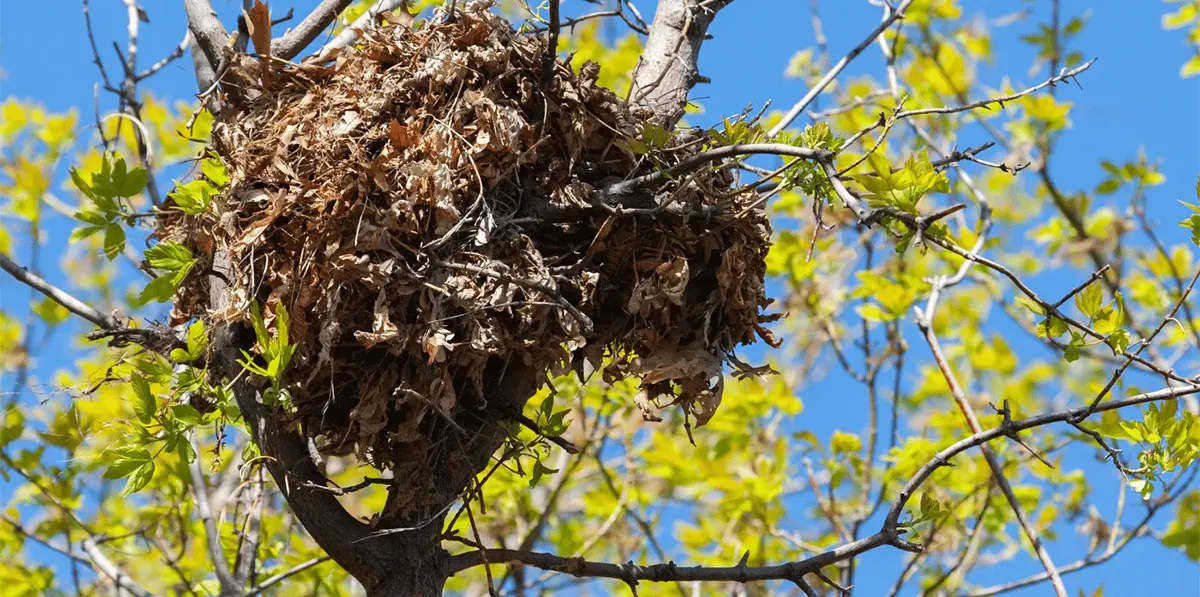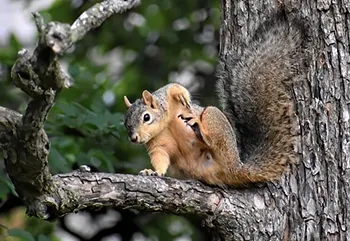Wow, that’s a loaded question! Did you know that there are over 250 types of squirrels? From ground squirrels and tree squirrels to flying squirrels and chipmunks. So, “Where do squirrels sleep at night” really can’t be answered generically.

Types of Squirrel Nests
Squirrel nests are generally called “dreys.” Dreys are intricate structures set up on tree branches, within tree cavities, or even burrowed into the ground. The type and location of each squirrel nest depends on its occupants and their needs. It is interesting to note that both male and female squirrels build nests or dreys and often have a second “back-up” nest, a little less sophisticated, but able to provide a quick get away if pursued by predators.
Tree Cavities (Den)
Like many other mammals (and some birds!), squirrels build their dens in tree cavities for protection from predators and weather. In fact, an abandoned woodpecker home will do just fine. The hollow space in the tree trunk is layered with moss and twigs, including a leaf lining for the bottom and sides. This allows for comfort and warmth during the winter months for adults and young’uns alike.
Ground Burrows
Some squirrel species, like the Eastern chipmunk, build down instead of up. They burrow into the ground and construct their nests there. This keeps them safe from above-ground predators and harsh weather conditions and helps keep their young hidden away and out of harm’s way., the squirrel burrows are constructed by digging and arranging materials, demonstrating squirrels’ ability to adapt to their environment.
In Chimneys, Attics, and Other Human Structure
Yeah, those we really don’t want to see. Again, being smart and highly adaptive little critters, squirrels will happily seek shelter in your home as well. A squirrel nest in your attic will likely contain materials found inside and outdoors. Look for twigs and leaves intertwined with bits of insulation or cloth materials. Check out suggestions for Animal Wildlife Exclusion »
Seasonal Sleeping Habits
Squirrels are known to be intelligent and adaptable little survivors, and their sleeping habits reflect that as well. Their sleep patterns and habits are influenced by temperature, predators, and food availability. In general, squirrels take naps of 15 minutes up to an hour or more, totalling about 14 hours in a 24 hour period.
Summer Sleeping
Unlike other known backyard pests, squirrels are diurnal - not nocturnal. That means, they are more active during the day, and sleep at night. However, during heat waves during the summer, they may alter their sleep rotation and nap in their dreys during the hottest part of the day and do most of their foraging in the cooler evening hours.
Winter Hibernation vs. Torpor
Ground squirrels may actually truly hibernate. They disappear underground for a couple of months and enter a deep sleep, lowering their body temperature, heart rate, and need for energy. But most of the species we see in Canada do not. Squirrels are exceedingly well equipped to deal with cold temperatures, with several layers of fur that can be “fluffed up” and provide excellent insulation. Several squirrels will also shack up and huddle to keep warm. However, most squirrels will sleep more (and deeper) during the winter months.
Squirrels are industrious critters and will have spent the fall collecting and storing feed for the colder months. Even when there is no food to be had, they will be able to go back to their stashes.
How Squirrels Choose Their Sleeping Spots
 Squirrels, like all wildlife, will look for sleeping spots that are safe and close to food and water. Of course, that means they are likely to show up in your yard or shed or attic.
Squirrels, like all wildlife, will look for sleeping spots that are safe and close to food and water. Of course, that means they are likely to show up in your yard or shed or attic.
Safety from Predators
All of squirrels’ nesting sites are chosen with predators in mind. A drey high up in a tree provides an excellent vantage point to survey the surroundings, and keeps squirrels out of reach of ground predators. A tree cavity does less for surveillance but provides great protection from larger predators. Ground burrows also lend themselves perfectly to drop out of sight when a ground predator is in hot pursuit.
Proximity to Food Sources
Again, like all other wildlife, food and water is essential and if one wants to survive, one must make sure those things are readily available. So, the tree in your backyard may be the perfect place to hang out; it’s up high and your bird feeders provide a never ending buffet.
Weather Protection
Weather can actually be a big problem for squirrels. Where do squirrels sleep when it rains? Dreys have been known to get flooded in heavy rain storms, killing unattended babies in the process. If momma squirrel is around, she may use her tail to shield her young from the rain, essentially offering them (and the drey) an umbrella. During spring or fall and where heavy rain can be expected, squirrels will often opt for a tree cavity instead.
Preventing Squirrels from Nesting in Unwanted Areas
We’ve touched on this above - YOUR yard, your shed, your attic or chimney may look like excellent nesting sites to our nimble friend, the squirrel. And, while they are quite entertaining to watch, having one in your home (and trying to get it out!) is no laughing matter. The damage these small creatures can leave behind is actually quite impressive - and costly to repair.
Sealing Entry Points
Walking around your home (and yes, inspecting the roof) twice a year is a must. Repair and seal any damages, cracks or holes you discover. Even a loose shingle can be exploited to gain access to your home.
Trimming Trees and Branches
Make your roof as inaccessible as possible. Remove any branches from trees or large shrubs that would allow squirrels to make the jump to your roof. If you have a fence that could provide roof access, consider Electric Shock Tracks as a non-lethal
Remove or Modify Bird Feeders
Bird feeders are one of squirrels’ favorites! And rightfully so… who doesn’t like an all-you-can-eat buffet? If squirrels cause a problem in your yard, it may be time to take away the buffet. Or, change the seating arrangement. Have a look at How to keep Squirrels away from Bird Feeders.
Using Deterrents
If you have a fence that could provide roof access, consider Electric Shock Tracks as a non-lethal squirrel deterrent (works wonders for raccoons, too!).
Wire mesh can be installed around or in areas where squirrels could otherwise nest, and there are a number of smells that squirrels aren’t particularly fond of. Those include garlic, onion, cider vinegar, and peppermint oil.
There are also commercially available deterrents using predator urine (coyote, fox, etc.)
Contact Hawkeye for Expert Squirrel Management
If you find that your attic is hosting a squirrel or five, it may be time to call in the Professionals. From disturbed insulation to chewed wiring and potential fire hazards, squirrels can do great damage to your home and safety and catching the little rascals isn’t always easy.
Hawkeye Bird & Animal Control has extensive experience with squirrel removal and management, including necessary repairs and prevention of squirrels returning.














